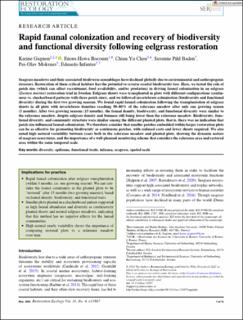| dc.description.abstract | Seagrass meadows and their associated biodiverse assemblages have declined globally due to environmental and anthropogenic stressors. Restoration of these critical habitats has the potential to reverse coastal biodiversity loss. Here, we tested the role of patch size (which can affect recruitment, food availability, and/or predation) in driving faunal colonization in an eelgrass (Zostera marina) restoration trial in Sweden. Eelgrass shoots were transplanted in plots with different configurations (continuous vs. checkerboard patterns with three patch sizes), and we followed invertebrate colonization (biodiversity and functional diversity) during the first two growing seasons. We found rapid faunal colonization following the transplantation of eelgrass shoots in all plots with invertebrate densities reaching 50–80% of the reference meadow after only one growing season (3 months). After two growing seasons (15 months), the faunal density, biodiversity, and functional diversity were similar to the reference meadow, despite eelgrass density and biomass still being lower than the reference meadow. Biodiversity, functional diversity, and community structure were similar among the different planted plots, that is, there was no indication that patch size influenced faunal colonization. We therefore consider that smaller patches embedded within larger restoration plots can be as effective for promoting biodiversity as continuous patches, with reduced costs and fewer shoots required. We also noted high natural variability between years both in the reference meadow and planted plots, showing the dynamic nature of seagrass ecosystems, and the importance of a well-planned monitoring scheme that considers the reference area and restored area within the same temporal scale. | en_US |
